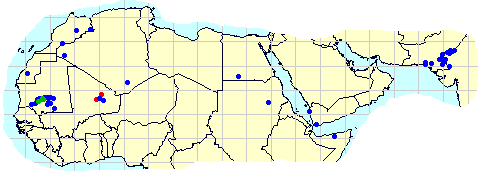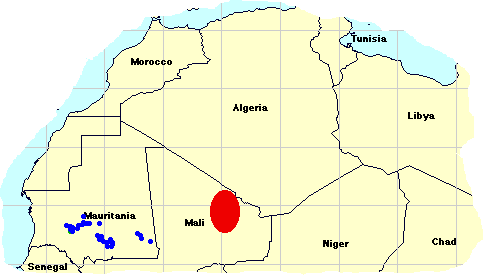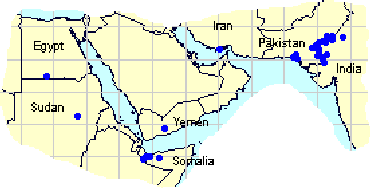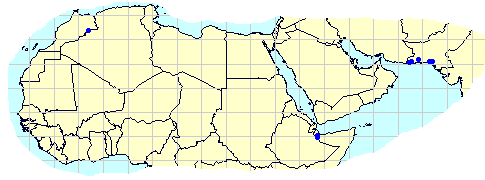11 November. Local outbreak continues in northern Mali
The Desert Locust situation continues to remain calm. A localized outbreak is in progress in northern Mali where small swarms and breeding have been reported. Low numbers of adults may appear in adjacent countries but the threat is considered very low. Elsewhere, small scale breeding is in progress in central Mauritania and isolated adults are present in a few places of Morocco, Algeria, Egypt, Sudan, northern Somalia and Yemen. Summer breeding along the Indo-Pakistan border has finished.

8 October. Local outbreak develops in northern Mali
The Desert Locust situation continues to remain calm. A localized outbreak has developed in northern Mali where small swarms have been reported. Green vegetation and good breeding conditions in the area will hold the populations there for another six weeks or so; therefore, the threat at this time to neighbouring countries is low. Elsewhere, small scale breeding is in progress in central Mauritania. No other significant populations have been reported.

16 September. Situation continues to remain calm
The Desert Locust situation continues to remain calm. Despite favourable conditions in the summer breeding areas of Africa and Asia, no significant infestations have been reported. Only low numbers of solitary adults are present along the Indo-Pakistan border, in southern Iran, Yemen, northern Somalia, Sudan and Egypt. Breeding on a small and non-threatening scale will probably occur in most of these areas in the coming weeks.

17 August. Situation continues to remain calm
No significant infestations have been reported. Only low numbers of solitary adults are present along the Indo-Pakistan border, southern Mauritania, Sudan and in northern Somalia. Although good rains have fallen in these areas, breeding will be on a small and non-threatening scale.
6 July. Calm situation continues
The Desert Locust situation remains calm and no significant infestations have been reported. Only low numbers of solitary adults are present along the Indo-Pakistan border where breeding conditions are favourable as a result of a cyclone in late May. Rains have not yet started in the summer breeding areas of the Sahel where it is dry except for south-eastern Mauritania. No significant developments are expected.
4 June. Situation remains calm
The Desert Locust situation continues to remain calm. No significant infestations have been reported from any country. Only isolated solitarious adults are present in parts of Morocco, northern Mauritania, south-eastern Egypt, northern Somalia, and western Pakistan. A cyclone caused heavy rains and flooding in south-eastern Pakistan which may allow early summer breeding along the Indo-Pakistan border.
No significant Desert Locust infestations have been reported from any country. Only low numbers of solitarious adults are present in parts of Morocco, northern Somalia, and western Pakistan. The situation is expected to remain calm in the coming weeks.

The situation is calm and no significant infestations have been reported from any country. Overall locust numbers are very low as a result of the failure of the rains in the Red Sea winter breeding areas. Rains fell recently in north-western Somalia and western Pakistan.
3 March. NE Africa outbreaks diminishing
The recent outbreak in NE Sudan and a second unrelated outbreak in SE Libya are both diminishing as a result of continuing control operations. The Libyan outbreak does not threaten neighbouring countries or regions. No significant developments are expected in breeding areas along the Red Sea coasts due to unusually dry conditions. Small scale breeding may start in western Pakistan where low numbers of adults are present. Elsewhere, the situation is calm.
18 February. NE Sudan outbreak declines; SE Libya outbreak continues
Control operations are coming to an end in north-eastern Sudan where swarms and bands were present as a result of a local outbreak. Escapees are likely to move east towards the Red Sea coastal plains where only insignificant numbers of locusts continue to be reported so far in Saudi Arabia. Small scale control operations continue in south-eastern Libya against groups of adults and small swarms. A few new infestations were recently found east of Kufra Oasis.
4 February. Control continues in NE Sudan but elsewhere is quiet
Control operations continued last month in north-eastern Sudan against swarms as a result of a local outbreak. Any escapees will not threaten North-West Africa. Instead, they will most likely move east towards the Red Sea coastal plains where only insignificant numbers of locusts are reported so far in Saudi Arabia. Recent rains on the coast will allow another generation of breeding but numbers will only slowly increase. Elsewhere, isolated adults were present in Iran and Mauritania.
5 January. NE Sudan outbreak continues & unusually dry conditions prevail on Red Sea coasts
Control operations continue in north-eastern Sudan against swarms that could move toward the Red Sea coastal areas where low numbers of locust are already present in Egypt, Eritrea, Saudi Arabia, and Yemen. Breeding so far has been limited by unusually dry conditions. Elsewhere, only isolated adults were present in Iran, Mauritania and Algeria.




